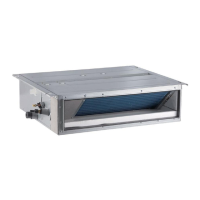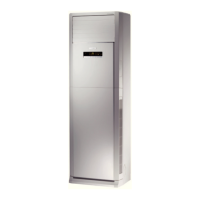GREE GMV5E DC INVERTER VRF UNITS SERVICE MANUAL
83
Starting the Silent Mode X Hours
after the Daytime Temperature
Reaches the Highest
Stopping the Nighttime
Silent Mode after Continual
Operations for Y Hours
Low- and
medium-noise mode
Note:
The highest daytime temperature is generally in 13:00-15:00.
For the forcible silent mode, the system runs in low-noise mode no matter in the daytime or
nighttime. The forcible silent mode falls in three categories:
Low- and medium-noise mode
Note:
The system capacity may fall off after the silent mode is set. Therefore, try to balance the
noise with the capacity in selecting a silent mode category.
The factory setting is “00”.
(4) A8 Aftersales vacuuming mode
This function ensures the vacuum degree of the entire system during maintenance to prevent
operation functions of dead zones. Expansion valves and electromagnetic valves of the unit will be
enabled after this function is set.
(5) n0 Conservation control 1
System conservation is set when conservation operations are required. The default factory setting is
capacity priority control mode. The system capacity may fall off after the conservation mode is set.
Conservation control – invalid (factory settings)
Conservation control - valid
(6) n3 Forcible defrosting operation
This function is set when forcible defrosting is required for the unit during maintenance. After this
function is enabled, the system automatically quits based on quitting conditions and then automatically
runs based on system conditions.
(7) n4 Conservation control 2
The highest capacity output limitation is set when users require forcibly limiting the system power
consumption. The setting scope is as follows:
Note: The cooling or heating effect may fall off after the capacity limitation is set.
(8) n5 Indoor unit project number offset
This function sets the IDU project number when multiple refrigerating systems are controlled in a
centralized manner (by using a remote monitor or centralized controller), avoiding the same project
number between different systems. If the project number is not set, project number conflicts may occur
